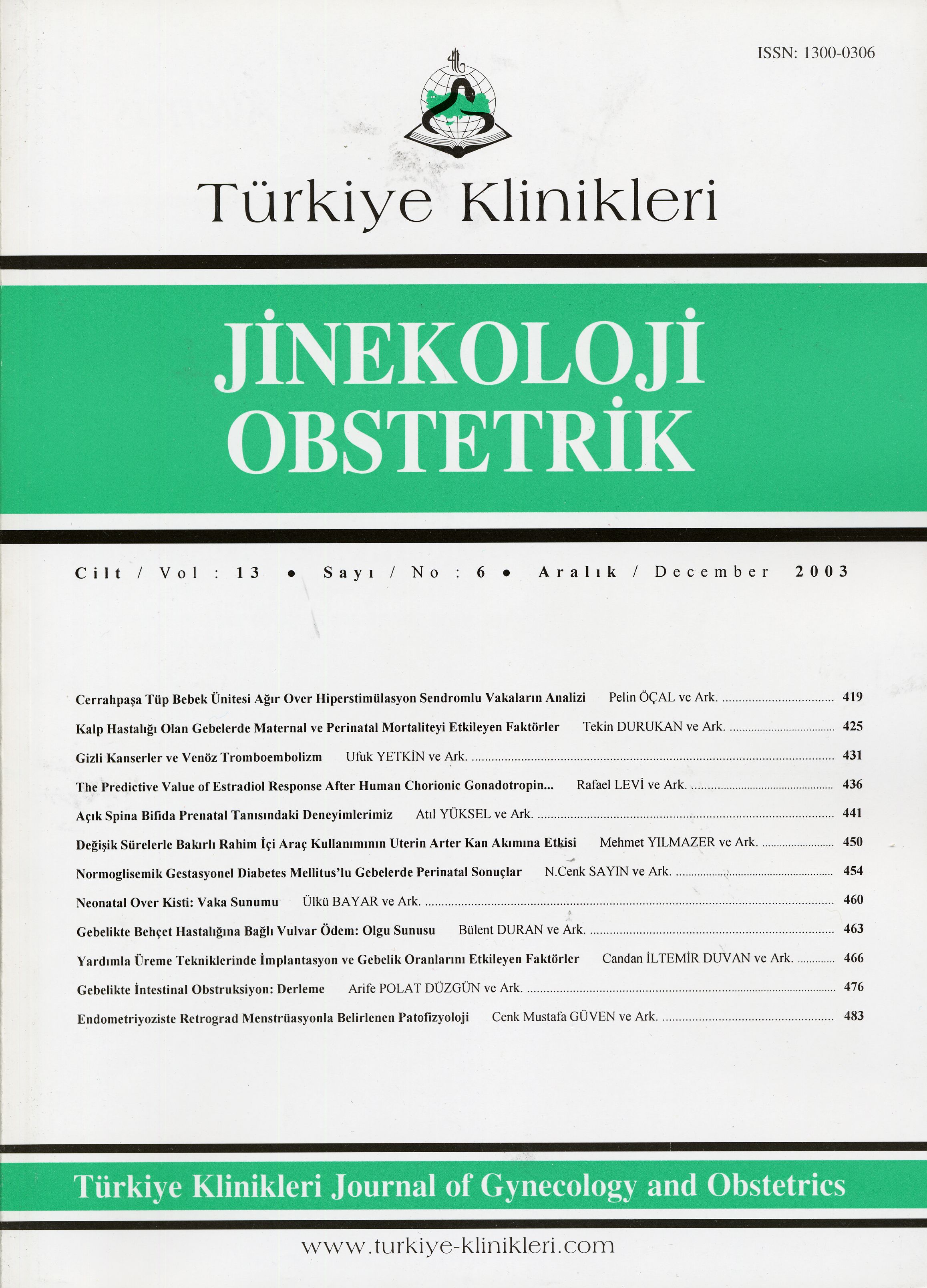Open Access
Peer Reviewed
ARTICLES
4546 Viewed1731 Downloaded
Factors Influencing Implantation And Pregnancy Rates In Assisted Reproductive Technology
Yardımla Üreme Tekniklerinde İmplantasyon ve Gebelik Oranlarını Etkileyen Faktörler
Turkiye Klinikleri J Gynecol Obst. 2003;13(6):466-75
Article Language: TR
Copyright Ⓒ 2025 by Türkiye Klinikleri. This is an open access article under the CC BY-NC-ND license (http://creativecommons.org/licenses/by-nc-nd/4.0/)
ÖZET
İlk invitro fertilizasyon bebeği olan Louis Brownun 1978de doğumundan beri yardımla üreme tekniklerinin (YÜT) uygulanma endikasyonları ve başarı oranları giderek artmıştır. Yardımla üreme teknikleri ile tedavide tüm gelişmelere rağmen en verimsiz basamak embryo transferi aşamasıdır. IVF programına katılan çiftlerin %80-85i oosit toplama ve takiben embryo transferi aşamasına ulaşsa bile implantasyon ve transfer başına gebelik oranları halen istenilen düzeylere ulaşmamıştır. IVF ile tedavi programına alınan hastalarda başarı oranlarını etkileyen faktörleri belirlemek amacıyla çok sayıda çalışma yapılmaktadır. YÜT ile tedavide başarılı sonuçlar elde etmek için öncelikle bu tedavi yöntemlerine uygun hastaların ve endikasyonlara göre uygun tedavi modalitelerinin seçimi önemlidir. Bugüne kadar yapılan çalışmalar sonucunda implantasyon ve gebelik oranlarını etkileyen başlıca faktörler arasında oosit/embro kalitesi ve uterin reseptivite yer almaktadır. Bu sebeple YÜT ile tedavide implantasyon ve gebelik oranlarını arttıracak bir yaklaşım hem uterin reseptiviteyi iyileştirmeye hem de yüksek kalitede embryo elde etmeye yönelik olmalıdır. Bu sunumda, YÜT endikasyonları, implantasyon fizyolojisi ve yardımla üreme teknikleri ile tedavi uygulamalarında implantasyon ve gebelik oranlarını etkileyen faktörlerden bahsedilmiştir.
İlk invitro fertilizasyon bebeği olan Louis Brownun 1978de doğumundan beri yardımla üreme tekniklerinin (YÜT) uygulanma endikasyonları ve başarı oranları giderek artmıştır. Yardımla üreme teknikleri ile tedavide tüm gelişmelere rağmen en verimsiz basamak embryo transferi aşamasıdır. IVF programına katılan çiftlerin %80-85i oosit toplama ve takiben embryo transferi aşamasına ulaşsa bile implantasyon ve transfer başına gebelik oranları halen istenilen düzeylere ulaşmamıştır. IVF ile tedavi programına alınan hastalarda başarı oranlarını etkileyen faktörleri belirlemek amacıyla çok sayıda çalışma yapılmaktadır. YÜT ile tedavide başarılı sonuçlar elde etmek için öncelikle bu tedavi yöntemlerine uygun hastaların ve endikasyonlara göre uygun tedavi modalitelerinin seçimi önemlidir. Bugüne kadar yapılan çalışmalar sonucunda implantasyon ve gebelik oranlarını etkileyen başlıca faktörler arasında oosit/embro kalitesi ve uterin reseptivite yer almaktadır. Bu sebeple YÜT ile tedavide implantasyon ve gebelik oranlarını arttıracak bir yaklaşım hem uterin reseptiviteyi iyileştirmeye hem de yüksek kalitede embryo elde etmeye yönelik olmalıdır. Bu sunumda, YÜT endikasyonları, implantasyon fizyolojisi ve yardımla üreme teknikleri ile tedavi uygulamalarında implantasyon ve gebelik oranlarını etkileyen faktörlerden bahsedilmiştir.
ANAHTAR KELİMELER: Yardımla üreme teknikleri, İmplantasyon, Gebelik oranları, Endometriyal reseptivite
ABSTRACT
The indications of assisted reproductive technology (ART) and the success rates are increasing gradually since the birth of Louis Brown; the first invitro fertilization (IVF) baby, in 1978. In spite of advancement in treatment with the assisted reproductive technology, we still are not successful enough in the embryo transfer stage. Although the oocyte pick up can be performed successfully in 80-85%of couples taking IVF pro-gram, the implantation and pregnancy rates per transfer are not at expected values. There are multiple data about the factors affecting the success rates of IVF programmes in the literature. The most important factor for the success of an IVF program is the selection of the patient group and the application of the appropriate treatment strategy to the patient. In the literature the main factors affecting the implantation and pregnanacy rates are oocyte and embryo quality and the uterine receptivity. According to this data to increase the implantation and preg-nancy rates, we should try to increase the uterine receptivity and embryo quality. The subjects of this review are the indica-tions of assisted reproductive technology, the physiology of implantation and the factors affecting the implantation and pregnancy rates in assisted reproductive technology.
The indications of assisted reproductive technology (ART) and the success rates are increasing gradually since the birth of Louis Brown; the first invitro fertilization (IVF) baby, in 1978. In spite of advancement in treatment with the assisted reproductive technology, we still are not successful enough in the embryo transfer stage. Although the oocyte pick up can be performed successfully in 80-85%of couples taking IVF pro-gram, the implantation and pregnancy rates per transfer are not at expected values. There are multiple data about the factors affecting the success rates of IVF programmes in the literature. The most important factor for the success of an IVF program is the selection of the patient group and the application of the appropriate treatment strategy to the patient. In the literature the main factors affecting the implantation and pregnanacy rates are oocyte and embryo quality and the uterine receptivity. According to this data to increase the implantation and preg-nancy rates, we should try to increase the uterine receptivity and embryo quality. The subjects of this review are the indica-tions of assisted reproductive technology, the physiology of implantation and the factors affecting the implantation and pregnancy rates in assisted reproductive technology.
MENU
POPULAR ARTICLES
MOST DOWNLOADED ARTICLES





This journal is licensed under a Creative Commons Attribution-NonCommercial-NoDerivatives 4.0 International License.










